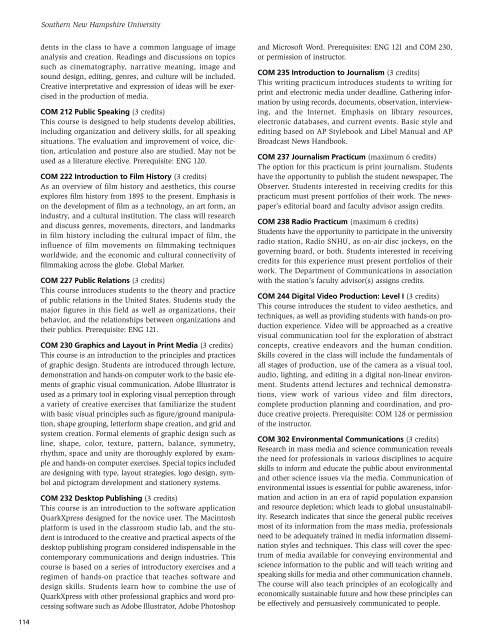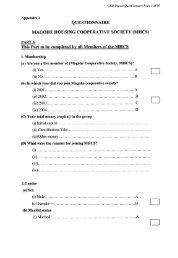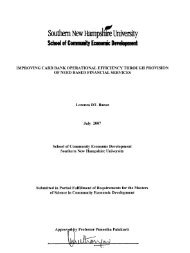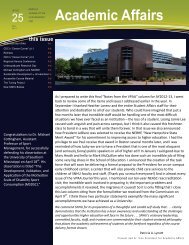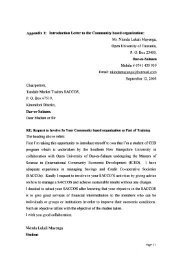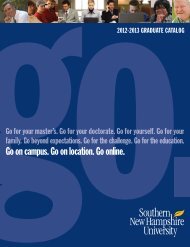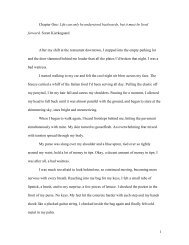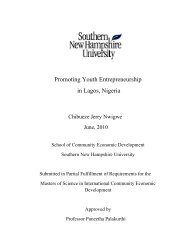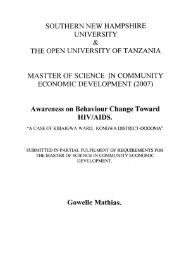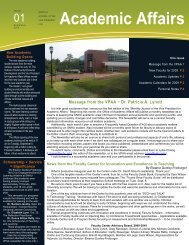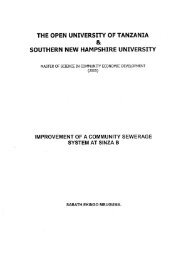Undergraduate Catalog 2010-2011 - SNHU Academic Archive ...
Undergraduate Catalog 2010-2011 - SNHU Academic Archive ...
Undergraduate Catalog 2010-2011 - SNHU Academic Archive ...
You also want an ePaper? Increase the reach of your titles
YUMPU automatically turns print PDFs into web optimized ePapers that Google loves.
Southern New Hampshire University<br />
dents in the class to have a common language of image<br />
analysis and creation. Readings and discussions on topics<br />
such as cinematography, narrative meaning, image and<br />
sound design, editing, genres, and culture will be included.<br />
Creative interpretative and expression of ideas will be exercised<br />
in the production of media.<br />
COM 212 Public Speaking (3 credits)<br />
This course is designed to help students develop abilities,<br />
including organization and delivery skills, for all speaking<br />
situations. The evaluation and improvement of voice, diction,<br />
articulation and posture also are studied. May not be<br />
used as a literature elective. Prerequisite: ENG 120.<br />
COM 222 Introduction to Film History (3 credits)<br />
As an overview of film history and aesthetics, this course<br />
explores film history from 1895 to the present. Emphasis is<br />
on the development of film as a technology, an art form, an<br />
industry, and a cultural institution. The class will research<br />
and discuss genres, movements, directors, and landmarks<br />
in film history including the cultural impact of film, the<br />
influence of film movements on filmmaking techniques<br />
worldwide, and the economic and cultural connectivity of<br />
filmmaking across the globe. Global Marker.<br />
COM 227 Public Relations (3 credits)<br />
This course introduces students to the theory and practice<br />
of public relations in the United States. Students study the<br />
major figures in this field as well as organizations, their<br />
behavior, and the relationships between organizations and<br />
their publics. Prerequisite: ENG 121.<br />
COM 230 Graphics and Layout in Print Media (3 credits)<br />
This course is an introduction to the principles and practices<br />
of graphic design. Students are introduced through lecture,<br />
demonstration and hands-on computer work to the basic elements<br />
of graphic visual communication. Adobe Illustrator is<br />
used as a primary tool in exploring visual perception through<br />
a variety of creative exercises that familiarize the student<br />
with basic visual principles such as figure/ground manipulation,<br />
shape grouping, letterform shape creation, and grid and<br />
system creation. Formal elements of graphic design such as<br />
line, shape, color, texture, pattern, balance, symmetry,<br />
rhythm, space and unity are thoroughly explored by example<br />
and hands-on computer exercises. Special topics included<br />
are designing with type, layout strategies, logo design, symbol<br />
and pictogram development and stationery systems.<br />
COM 232 Desktop Publishing (3 credits)<br />
This course is an introduction to the software application<br />
QuarkXpress designed for the novice user. The Macintosh<br />
platform is used in the classroom studio lab, and the student<br />
is introduced to the creative and practical aspects of the<br />
desktop publishing program considered indispensable in the<br />
contemporary communications and design industries. This<br />
course is based on a series of introductory exercises and a<br />
regimen of hands-on practice that teaches software and<br />
design skills. Students learn how to combine the use of<br />
QuarkXpress with other professional graphics and word processing<br />
software such as Adobe Illustrator, Adobe Photoshop<br />
and Microsoft Word. Prerequisites: ENG 121 and COM 230,<br />
or permission of instructor.<br />
COM 235 Introduction to Journalism (3 credits)<br />
This writing practicum introduces students to writing for<br />
print and electronic media under deadline. Gathering information<br />
by using records, documents, observation, interviewing,<br />
and the Internet. Emphasis on library resources,<br />
electronic databases, and current events. Basic style and<br />
editing based on AP Stylebook and Libel Manual and AP<br />
Broadcast News Handbook.<br />
COM 237 Journalism Practicum (maximum 6 credits)<br />
The option for this practicum is print journalism. Students<br />
have the opportunity to publish the student newspaper, The<br />
Observer. Students interested in receiving credits for this<br />
practicum must present portfolios of their work. The newspaper’s<br />
editorial board and faculty advisor assign credits.<br />
COM 238 Radio Practicum (maximum 6 credits)<br />
Students have the opportunity to participate in the university<br />
radio station, Radio <strong>SNHU</strong>, as on-air disc jockeys, on the<br />
governing board, or both. Students interested in receiving<br />
credits for this experience must present portfolios of their<br />
work. The Department of Communications in association<br />
with the station’s faculty advisor(s) assigns credits.<br />
COM 244 Digital Video Production: Level I (3 credits)<br />
This course introduces the student to video aesthetics, and<br />
techniques, as well as providing students with hands-on production<br />
experience. Video will be approached as a creative<br />
visual communication tool for the exploration of abstract<br />
concepts, creative endeavors and the human condition.<br />
Skills covered in the class will include the fundamentals of<br />
all stages of production, use of the camera as a visual tool,<br />
audio, lighting, and editing in a digital non-linear environment.<br />
Students attend lectures and technical demonstrations,<br />
view work of various video and film directors,<br />
complete production planning and coordination, and produce<br />
creative projects. Prerequisite: COM 128 or permission<br />
of the instructor.<br />
COM 302 Environmental Communications (3 credits)<br />
Research in mass media and science communication reveals<br />
the need for professionals in various disciplines to acquire<br />
skills to inform and educate the public about environmental<br />
and other science issues via the media. Communication of<br />
environmental issues is essential for public awareness, information<br />
and action in an era of rapid population expansion<br />
and resource depletion; which leads to global unsustainability.<br />
Research indicates that since the general public receives<br />
most of its information from the mass media, professionals<br />
need to be adequately trained in media information dissemination<br />
styles and techniques. This class will cover the spectrum<br />
of media available for conveying environmental and<br />
science information to the public and will teach writing and<br />
speaking skills for media and other communication channels.<br />
The course will also teach principles of an ecologically and<br />
economically sustainable future and how these principles can<br />
be effectively and persuasively communicated to people.<br />
114


